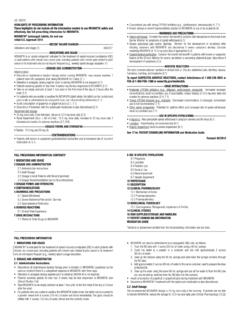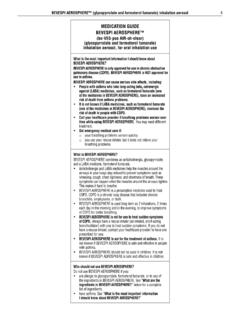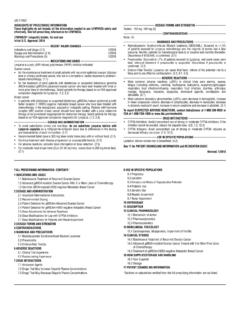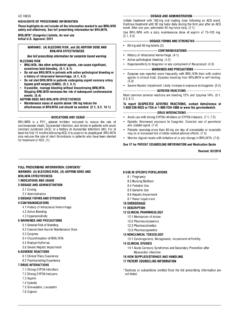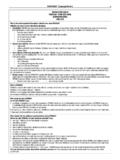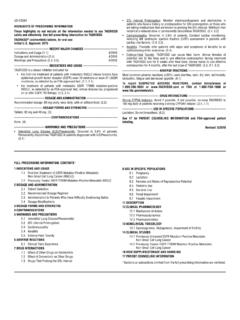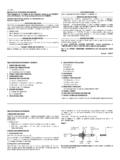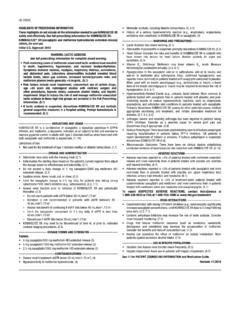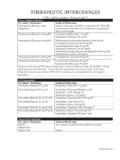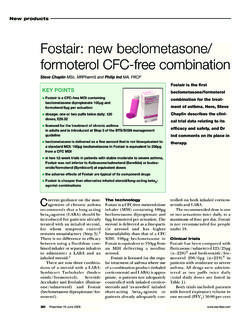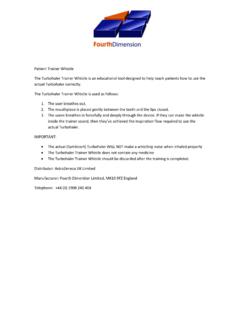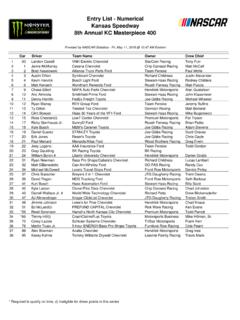Transcription of HIGHLIGHTS OF PRESCRIBING INFORMATION - PI …
1 HIGHLIGHTS OF PRESCRIBING INFORMATIONT hese HIGHLIGHTS do not include all the INFORMATION needed to use symbicort safely and effectively. See full PRESCRIBING INFORMATION for (budesonide and formoterol fumarate dihydrate)Inhalation Aerosol, for oral inhalation useInitial Approval: 2006------------------------------------ ---- RECENT MAJOR CHANGES ---------------------------------------B ox Warning, removed 12/2017 Indications and Usage ( ) 12/2017 Indications and Usage ( ) 9/2017 Warnings and Precautions ( ) 12/2017--------------------------------- ------- INDICATIONS AND USAGE ---------------------------------------- symbicort is a combination product containing a corticosteroid and a long-acting beta2-adrenergic agonist indicated for: Treatment of asthma in patients 6 years of age and older. ( ) Maintenance treatment of airflow obstruction and reducing exacerbations in patients with chronic obstructive pulmonary disease (COPD) including chronic bronchitis and/or emphysema.
2 ( )Important limitations: Not indicated for the relief of acute bronchospasm. ( , )------------------------------------ DOSAGE AND ADMINISTRATION ------------------------------------For oral inhalation only. Treatment of asthma in patients 12 years and older: 2 inhalations of symbicort 80 or 160 twice daily. Starting dosage is based on asthma severity. ( ) Treatment of asthma in patients aged 6 to less than 12 years: 2 inhalations of symbicort 80 twice daily. ( ) Maintenance treatment in COPD: 2 inhalations of symbicort 160 twice daily. ( )---------------------------------- DOSAGE FORMS AND STRENGTHS -----------------------------------Meter ed-dose inhaler containing a combination of budesonide (80 or 160 mcg) and formoterol ( mcg) as an inhalation aerosol. (3)------------------------------------- ----- CONTRAINDICATIONS ---------------------------------------- -- Primary treatment of status asthmaticus or acute episodes of asthma or COPD requiring intensive measures (4) Hypersensitivity to any of the ingredients in symbicort (4)------------------------------------ WARNINGS AND PRECAUTIONS ------------------------------------ Serious asthma-related events: Long-acting beta2-adrenergic agonists as monotherapy increase the risk.
3 ( ) Deterioration of disease and acute episodes: Do not initiate in acutely deteriorating asthma or COPD or to treat acute symptoms. ( ) Use with additional long-acting beta2-agonist: Do not use in combination because of risk of overdose. ( ) Localized infections: Candida albicans infection of the mouth and throat may occur. Monitor patients periodically for signs of adverse effects on the oral cavity. Advise the patient to rinse his/her mouth with water without swallowing after inhalation to help reduce the risk. ( ) Pneumonia: Increased risk in patients with COPD. Monitor patients for signs and symptoms of pneumonia and other potential lung infections. ( ) Immunosuppression: Potential worsening of infections ( , existing tuberculosis, fungal, bacterial, viral, or parasitic infection; or ocular herpes simplex). Use with caution in patients with these infections. More serious or even fatal course of chickenpox or measles can occur in susceptible patients.
4 ( ) Transferring patients from systemic corticosteroids: Risk of impaired adrenal function when transferring from oral steroids. Taper patients slowly from systemic corticosteroids if transferring to symbicort . ( ) Hypercorticism and adrenal suppression: May occur with very high dosages or at the regular dosage in susceptible individuals. If such changes occur, discontinue symbicort slowly. ( ) Strong cytochrome P450 3A4 inhibitors ( , ritonavir): Risk of increased systemic corticosteroid effects. Exercise caution when used with symbicort . ( ) Paradoxical bronchospasm: Discontinue symbicort and institute alternative therapy if paradoxical bronchospasm occurs. ( ) Patients with cardiovascular or central nervous system disorders: Use with caution because of beta-adrenergic stimulation. ( ) Decreases in bone mineral density: Assess bone mineral density initially and periodically thereafter. ( ) Effects on growth: Monitor growth of pediatric patients.
5 ( ) Glaucoma and cataracts: Close monitoring is warranted. ( ) Metabolic effects: Be alert to eosinophilic conditions, hypokalemia, and hyperglycemia. ( , ) Coexisting conditions: Use with caution in patients with convulsive disorders, thyrotoxicosis, diabetes mellitus, and ketoacidosis. ( )--------------------------------------- --- ADVERSE REACTIONS ---------------------------------------- -Most common adverse reactions (incidence >3%) are: Asthma: nasopharyngitis, headache, upper respiratory tract infection, pharyngolaryngeal pain, sinusitis, influenza, back pain, nasal congestion, stomach discomfort, vomiting, and oral candidiasis. ( ) COPD: nasopharyngitis, oral candidiasis, bronchitis, sinusitis, upper respiratory tract infections. ( )To report SUSPECTED ADVERSE REACTIONS, contact AstraZeneca at 1-800-236-9933 or FDA at 1-800-FDA-1088 or DRUG INTERACTIONS ---------------------------------------- --- Strong cytochrome P450 3A4 inhibitors ( , ritonavir): Use with caution.
6 May cause increased systemic corticosteroid effects. ( ) Monoamine oxidase inhibitors and tricyclic antidepressants: Use with extreme caution. May potentiate effect of formoterol on vascular system. ( ) Beta-blockers: Use with caution. May block bronchodilatory effects of beta-agonists and produce severe bronchospasm. ( ) Diuretics: Use with caution. Electrocardiographic changes and/or hypokalemia associated with non-potassium-sparing diuretics may worsen with concomitant beta-agonists. ( )----------------------------------- USE IN SPECIFIC POPULATIONS -------------------------------------Hep atic impairment: Monitor patients for signs of increased drug exposure. ( )See 17 for PATIENT COUNSELING INFORMATION and FDA-approved patient labelingRevised: 12/2017US-17028 FULL PRESCRIBING INFORMATION : CONTENTS*1 INDICATIONS AND USAGE Treatment of Asthma Maintenance Treatment of Chronic Obstructive Pulmonary Disease2 DOSAGE AND ADMINISTRATION Administration INFORMATION Asthma Chronic Obstructive Pulmonary Disease3 DOSAGE FORMS AND STRENGTHS4 CONTRAINDICATIONS5 WARNINGS AND PRECAUTIONS Serious Asthma-Related Events Hospitalizations.
7 Intubations and Death Deterioration of Disease and Acute Episodes Excessive Use of symbicort and Use with Other Long-Acting Beta2-Agonists Local Effects Pneumonia and Other Lower Respiratory Tract Infections Immunosuppression Transferring Patients From Systemic Corticosteroid Therapy Hypercorticism and Adrenal Suppression Drug Interactions With Strong Cytochrome P450 3A4 Inhibitors Paradoxical Bronchospasm and Upper Airway Symptoms Immediate Hypersensitivity Reactions Cardiovascular and Central Nervous System Effects Reduction in Bone Mineral Density Effect on Growth Glaucoma and Cataracts Eosinophilic Conditions and Churg-Strauss Syndrome Coexisting Conditions Hypokalemia and Hyperglycemia6 ADVERSE REACTIONS Clinical Trials Experience in Asthma Clinical Trials Experience in Chronic Obstructive Pulmonary Disease Postmarketing Experience7 DRUG INTERACTIONS Inhibitors of Cytochrome P4503A4 Monoamine Oxidase Inhibitors and Tricyclic Antidepressants Beta-Adrenergic Receptor Blocking Agents Diuretics8 USE IN SPECIFIC POPULATIONS Pregnancy Lactation Pediatric Use Geriatric Use Hepatic Impairment Renal Impairment10 OVERDOSAGE11 DESCRIPTION12 CLINICAL PHARMACOLOGY Mechanism of Action Pharmacodynamics Pharmacokinetics13 NONCLINICAL TOXICOLOGY Carcinogenesis, Mutagenesis.
8 Impairment of Fertility Animal Toxicology and/or Pharmacology14 CLINICAL STUDIES Asthma Chronic Obstructive Pulmonary Disease16 HOW SUPPLIED/STORAGE AND HANDLING17 PATIENT COUNSELING INFORMATION *Sections or subsections omitted from the full PRESCRIBING INFORMATION are not PRESCRIBING INFORMATION1 INDICATIONS AND Treatment of AsthmaSYMBICORT is indicated for the treatment of asthma in patients 6 years of age and should be used for patients not adequately controlled on a long-term asthma-control medication such as an inhaled corticosteroid (ICS) or whose disease warrants initiation of treatment with both an inhaled corticosteroid and long-acting beta2-adrenergic agonist (LABA).Important Limitations of Use: symbicort is NOT indicated for the relief of acute Maintenance Treatment of Chronic Obstructive Pulmonary DiseaseSYMBICORT 160 is indicated for the maintenance treatment of airflow obstruction in patients with chronic obstructive pulmonary disease (COPD) including chronic bronchitis and/or emphysema.
9 symbicort 160 is also indicated to reduce exacerbations of COPD. symbicort 160 is the only strength indicated for the treatment of Limitations of Use: symbicort is NOT indicated for the relief of acute DOSAGE AND Administration InformationSYMBICORT should be administered as 2 inhalations twice daily (morning and evening, approximately 12 hours apart), every day by the orally inhaled route only. After inhalation, the patient should rinse the mouth with water without symbicort before using for the first time by releasing two test sprays into the air away from the face, shaking well for 5 seconds before each spray. In cases where the inhaler has not been used for more than 7 days or when it has been dropped, prime the inhaler again by shaking well before each spray and releasing two test sprays into the air away from the frequent administration or a higher number of inhalations (more than 2 inhalations twice daily) of the prescribed strength of symbicort is not recommended as some patients are more likely to experience adverse effects with higher doses of formoterol.
10 Patients using symbicort should not use additional LABA for any reason [see Warnings and Precautions ( , )]. AsthmaIf asthma symptoms arise in the period between doses, an inhaled, short-acting beta2-agonist should be taken for immediate and Adolescent Patients 12 Years of Age and Older For patients 12 years of age and older, the dosage is 2 inhalations of symbicort 80 or symbicort 160 twice recommended starting dosages for symbicort for patients 12 years of age and older are based upon patients asthma severity or level of control of asthma symptoms, and risk of exacerbations on current inhaled maximum recommended dosage in adult and adolescent patients 12 years and older is symbicort 160 , two inhalations twice in asthma control following inhaled administration of symbicort can occur within 15 minutes of beginning treatment, although maximum benefit may not be achieved for 2 weeks or longer after beginning treatment.
